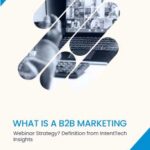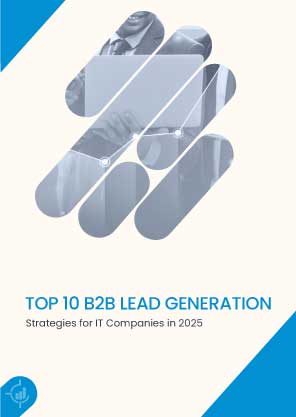or call: +1 (845) 347-8894

or call: +1 (845) 347-8894

In 2025, B2B buyers are no longer simply clicking on ads or downloading white papers. Rather, they are always dropping cryptic intent signals via their online behavior, hiring patterns, and public activity. The actual question is whether IT businesses are ready to pick up on those signals before opponents do.
Lead generation now is not about touching all. It is touching the right decision-makers at the right moment with the right message. For IT businesses in a crowded and rapidly moving market, this means making a strategic change.
This article shares 10 lead generation strategies customized for 2025 that enable IT companies to forge deeper connections, turn intent into opportunity, and keep pace with evolving buyer expectations.
Classic demographic filters like company size or job title are no longer sufficient to engage the attention of buyers. Rather, micro-targeting peeks deeper into the very particular real-time surroundings of each prospect. Consider an edge computing solutions provider. Tracking industry news, social media, and corporate releases, they hear about a prospect’s supply chain slowdowns or product launches. Armed with that information, the outreach makes mention of those very particular issues.
For instance, an IT supplier can contact a manufacturing company following the sighting of news regarding interrupted supply chains, with edge computing solutions that minimize downtime and maximize real-time visibility. Such contextual appropriateness can only be achieved by bringing together news feeds, social listening technology, and intent data in marketing processes, which nimble IT players are quickly embracing in order to get ahead of the competition.
Today’s IT lead generation goes beyond specific target accounts. Rather, organizations chart whole ecosystems of partners, competitors, and related industries to map indirect lead channels. An example might be a cloud security firm charting the prospect’s ecosystem of SaaS providers, managed service providers, and regulatory agencies. They then design multi-channel campaigns to get these stakeholders’ attention with tailor-made content.
By involving ecosystem participants in webinars or co-branded content, companies build credibility and extend their reach within the prospect’s buying committee. Using a regulatory advisor in addition to IT decision-makers on compliance updates, for instance, brings an element of credibility that accelerates decision-making. Ecosystem mapping transforms lead gen from a single-person hunt to a team-based growth engine.
The emergence of voice AI tech brings new means to qualify and capture leads within natural conversations in the real world. Virtual conferences, sales calls, or customer support chats can now include AI assistants that listen for purchasing signals and qualify leads automatically.
For instance, on a cybersecurity webinar, a voice AI can sense an inquiry regarding ransomware defenses as a purchase signal. The attendee can be identified as having high intent, leading to quick follow-up sales with relevant materials. This real-time gathering of oral cues offers a more accurate and richer insight into prospect interest compared to click tracking by itself. Businesses that adopt voice AI early have the advantage of lead qualification, turning conversations into actionable pipelines earlier.
Reactive personalization based on previous behavior no longer suffices. Top IT companies leverage powerful AI models to forecast forthcoming buyer requirements by integrating behavioral information with outside indicators such as employment trends, fundraising rounds, or industry transformations.
Picture an IT opportunity recently onboarding several cloud architects. Predictive AI can deduce an impending cloud migration project and initiate proactively reaching out with messaging centered around migration risks and best practices. This pre-emptive personalization establishes sales teams as advisors of choice before prospects officially enter buying cycles. In 2025, companies that excel at predictive personalization accelerate time to close and expand deal sizes by engaging buyers at the right time with precisely what they require.
Immersive virtual worlds present a new opportunity for lead generation. Innovative IT organizations build virtual showrooms or innovation laboratories where visitors can experience products and solutions firsthand from anywhere.
For example, a cybersecurity firm can create a metaverse environment where prospects practice threat discovery and response, gaining firsthand knowledge of the product’s capabilities. Immersive experiences like these heighten engagement, enhance product knowledge, and foster trust beyond what static demos can accomplish. This new method is particularly attractive to technical buyers looking to ‘try before they buy’ and expedites qualification by sorting for seriously interested leads.
Co-creation with prospects shifts lead generation from one-way broadcast to a conversation that involves everyone. Encouraging early adopters to give their feedback using case studies, podcast interviews, or panel presentations generates real, trust-establishing content.
For instance, an enterprise SaaS company can partner with a customer on a co-branded webinar describing the deployment process and driving results. This not only produces engaging content but also makes prospects warm through social proof and authentic anecdotes. Co-branded content builds leads naturally and usually reveals additional pain points or objections that sales teams can approach beforehand.
With the era of increased privacy consciousness and regulation, ethical data openness is a strong differentiator. IT firms that are transparent about how they gather, retain, and utilize data gain the trust of prospects early on.
For instance, providing prospects with explicit control over their data preferences and defining compliance with regulations such as GDPR or CCPA can serve as a lead magnet of its own. Buyers, particularly in cybersecurity and compliance markets, appreciate vendors who are focused on privacy and transparency. Sharing educational content around data ethics with your solutions makes your brand credible and draws better-quality leads who place value on integrity.
Though global access continues to be important, hyper-localized community creation produces leads through real, active peer networks. IT firms build or fund local meetups, city-based online groups, or regional forums centered around overcoming endemic challenges.
For example, a managed services company may sponsor quarterly roundtables for CIOs for a particular metro, focusing on regional compliance news or infrastructure headaches. These small, tight-knit communities build intense relationships and create referrals. In 2025, these specialized ecosystems will offer high-trust lead pools that national campaigns cannot match.
Lead leakage is a significant concern for IT firms, but real-time alignment dashboards can address this. Bringing CRM, marketing automation, and intent data onto integrated platforms gives sales and marketing teams immediate insight into lead status, history of engagement, and priority levels.
For instance, if a marketing-qualified lead downloads a competitive analysis report, sales representatives get instant notifications to act before interest runs out. This quick follow-up minimizes lead drop-off and shortens sales cycles. Real-time alignment dashboards ensure no lead falls through the cracks and sales efforts concentrate on the most viable prospects.
The greatest IT marketers no longer view lead nurturing as a funnel step but as an ongoing relationship investment. Wooing leads with customized news of product advances, market trends, and peer success stories on a month-by-month or year-by-year basis establishes brand affinity.
For example, a cloud infrastructure provider might send quarterly technology impact reports tailored by industry sector, keeping their brand top of mind for prospects not yet ready to buy. This ongoing dialogue nurtures trust and primes leads for eventual conversion. It transforms lead generation from a transactional task into a long-term growth strategy.
The future of lead generation in IT lies in combining human insight with emerging technology to create not just leads but meaningful connections. By focusing on real-time context, ecosystem engagement, voice AI, immersive experiences, and ethical transparency, IT firms can build smarter, sustainable pipelines.
The key shift in 2025 is moving from volume chasing to quality cultivation, investing in lead wisdom over lead counts. Start adapting your lead generation strategies today with these fresh approaches to win faster, build trust deeper, and grow stronger in the evolving tech marketplace.
There’s no single best strategy, but a combination of intent data, AI-driven personalization, and value-led content marketing has proven highly effective. IT buyers in 2025 expect personalized experiences, not one-size-fits-all outreach.
Buyers now leave behind behavioral signals across digital channels. Instead of cold outreach, successful companies are tracking intent, analyzing behavior, and engaging prospects with tailored, timely offers.
Top-performing IT companies use tools that integrate AI, ABM (Account-Based Marketing), and automation. Platforms like 6sense, Demandbase, and HubSpot are often used to unify intent data, segmentation, and campaign execution.
Yes, but it must be intent-based and highly targeted. Generic syndication has low ROI. Companies that align content distribution with active buyer signals see stronger results.
Video continues to gain traction. Explainer videos, product walkthroughs, and expert interviews help simplify complex IT solutions and drive engagement, especially on platforms like LinkedIn and YouTube.
To participate in our interviews, please write to our IntentTech Media Room at sudipto@intentamplify.com
